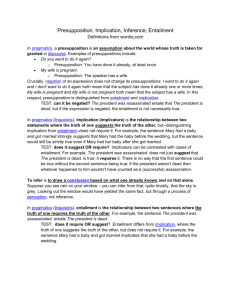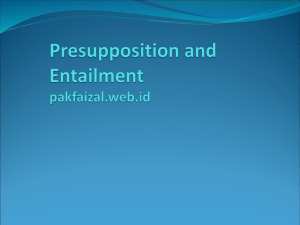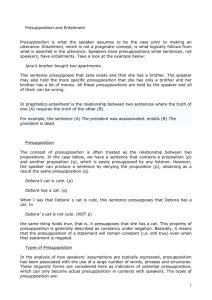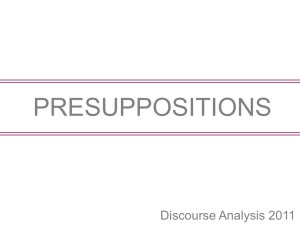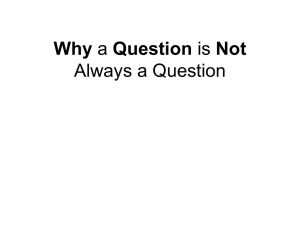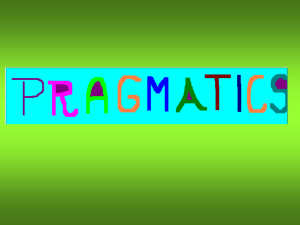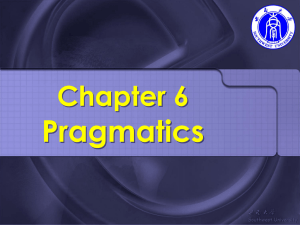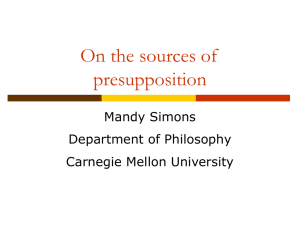Read More
advertisement
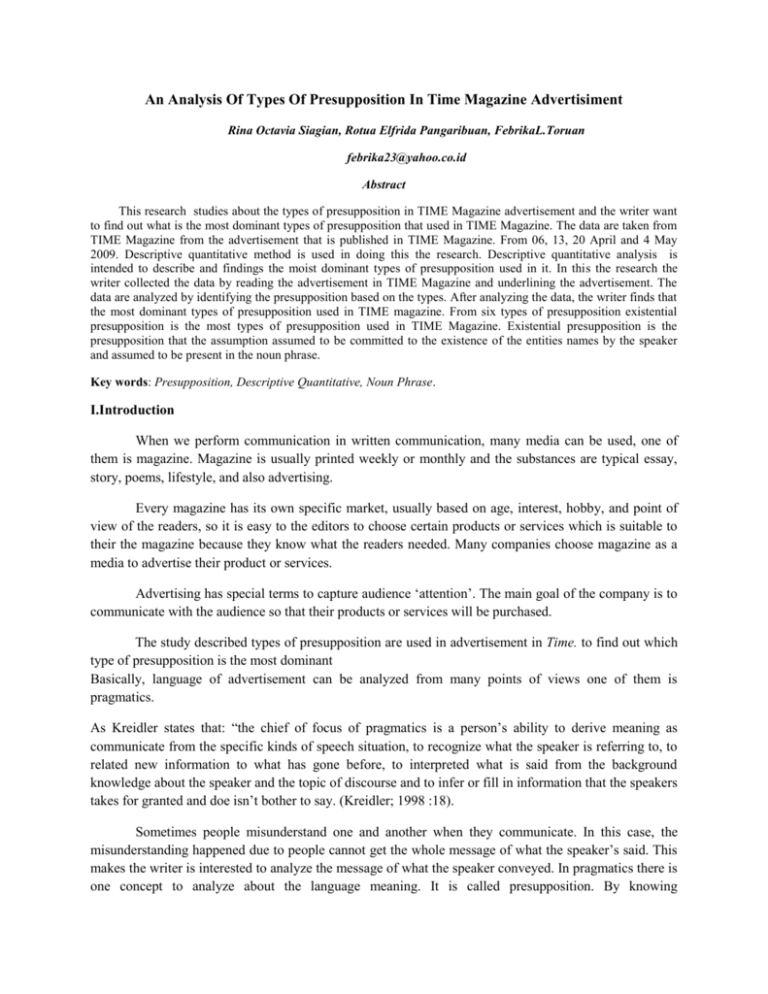
An Analysis Of Types Of Presupposition In Time Magazine Advertisiment Rina Octavia Siagian, Rotua Elfrida Pangaribuan, FebrikaL.Toruan febrika23@yahoo.co.id Abstract This research studies about the types of presupposition in TIME Magazine advertisement and the writer want to find out what is the most dominant types of presupposition that used in TIME Magazine. The data are taken from TIME Magazine from the advertisement that is published in TIME Magazine. From 06, 13, 20 April and 4 May 2009. Descriptive quantitative method is used in doing this the research. Descriptive quantitative analysis is intended to describe and findings the moist dominant types of presupposition used in it. In this the research the writer collected the data by reading the advertisement in TIME Magazine and underlining the advertisement. The data are analyzed by identifying the presupposition based on the types. After analyzing the data, the writer finds that the most dominant types of presupposition used in TIME magazine. From six types of presupposition existential presupposition is the most types of presupposition used in TIME Magazine. Existential presupposition is the presupposition that the assumption assumed to be committed to the existence of the entities names by the speaker and assumed to be present in the noun phrase. Key words: Presupposition, Descriptive Quantitative, Noun Phrase. I.Introduction When we perform communication in written communication, many media can be used, one of them is magazine. Magazine is usually printed weekly or monthly and the substances are typical essay, story, poems, lifestyle, and also advertising. Every magazine has its own specific market, usually based on age, interest, hobby, and point of view of the readers, so it is easy to the editors to choose certain products or services which is suitable to their the magazine because they know what the readers needed. Many companies choose magazine as a media to advertise their product or services. Advertising has special terms to capture audience ‘attention’. The main goal of the company is to communicate with the audience so that their products or services will be purchased. The study described types of presupposition are used in advertisement in Time. to find out which type of presupposition is the most dominant Basically, language of advertisement can be analyzed from many points of views one of them is pragmatics. As Kreidler states that: “the chief of focus of pragmatics is a person’s ability to derive meaning as communicate from the specific kinds of speech situation, to recognize what the speaker is referring to, to related new information to what has gone before, to interpreted what is said from the background knowledge about the speaker and the topic of discourse and to infer or fill in information that the speakers takes for granted and doe isn’t bother to say. (Kreidler; 1998 :18). Sometimes people misunderstand one and another when they communicate. In this case, the misunderstanding happened due to people cannot get the whole message of what the speaker’s said. This makes the writer is interested to analyze the message of what the speaker conveyed. In pragmatics there is one concept to analyze about the language meaning. It is called presupposition. By knowing presupposition people will get the whole message that is the spoken and unspoken one. The use of presupposition in advertising language can make the reader more interested in reading the advertisement; presupposition is one of important topics in pragmatics, because the speaker always communicates more than it is said. In presupposition, it is used some symbol such as “>>” means presuppose, “p” means proposition, and “q” means another proposition, which are easily presupposed by any listeners. However, the speaker can produce a sentence by denying the proposition (p), obtaining as a result of the other presupposition (q). “Debora’s cat is cute” (p), “Debora has a cat”(q); when it is said that Debora’s a cat is cute, this sentence presupposes that Debora has a cat. 1. Pragmatics Pragmatics is the branch of study that concerned with the study of meaning as communication by a speaker (or writer) and interpreted by a listener (or reader). It has consequently, more to do with the analysis of what people mean by their utterances than what the words or phrases in those utterances might mean by themselves (Yule; 1995) It means when someone stated sentences there are unspoken meanings from the speaker to the listener; and the listeners did the analysis of what the speaker meant of his/her utterances, and the analysis of the listener must include the linguistics, social, environment, and physiological factors to reach the goals in communication. In pragmatics, someone’s principles are often different in another. It is developed in interests in how people in different languages view a certain pragmatic principle. Cross linguistic and cross- cultural studies reported what is considered polite in one language is some not polite in another. Another focus of research in pragmatics is learner language or inters language. This interest eventually evolved into inter language pragmatics, a branch of pragmatics which specifically discusses how non- native speakers comprehend and produce a speech act in a target language and how their pragmatic competence develops overtime.(Kasper & Blum Kulka,1993; Kasper, 1995) Presupposition The term presupposition is derived from the word “suppose” which come from Latin and literary mean “to put under”, namely from sub (“under”) + phonere (“to put”). According to Merriam-Webster “Student Dictionary” to presuppose means to suppose beforehand or to require as an antecedent. In language and linguistic-a student’s dictionary (RL Trask:1997) stated that presupposition means a proposition whose truth must be taken for granted, if someone utterances is to be regarded as sensible. Rather, a presupposition should be studied from a pragmatic perspective or approach. Thus, “presupposition is something the speaker assumed to be case prior of making utterance” Yule (1996:25). Keenan (1997) holds that in presupposition in language, semantic presupposition and pragmatic presupposition and semantic presupposition. Semantic presupposition is subject to test like entailment under assertion and negation. Meanwhile, pragmatic presupposition based on the concept of appropriate usage. In development, it has become increasingly clear that presupposition differs from other semantic relations in that it is very sensitive to context. Rather, presupposition should be studied from a pragmatic perspective or approach. The pragmatic approach views sentences as utterances of individuals who are communicating through the language. As in pragmatic presupposition, there are generally three kinds of view points. First, pragmatics presupposition refers to the assumption made by the speaker about the context in the language communication takes places. Second, pragmatic presupposition is treated as a felicity condition for implementing some speech act, which is necessary to succeed of the speech act. Third, some linguist regards pragmatic presupposition as the mutual knowledge or common ground (join assumption) between the speaker and the listeners. However, these three kinds of ideas are closely connected (www.Geoolge.Com.sv. Presupposition). Furthermore Levinson (1983:179-180) said that a presupposition is a background belief, relating to an utterance, that: 1. Must be mutually know or assumed by the speaker and addressee or utterances to be considered appropriated in context. 2. Generally will remain a necessary assumption whether the utterances is place in the form of an assertion denial or question. 3. Generally, will be associated with a specific lexical item or grammatical feature (presupposition trigger) in the utterance. Based on the definitions above, it can be concluded that presupposition consists of a relationship between two propositions. For example: Positive sentence: Negative sentences: a. Benny’s dog is cute (p) b. Benny has a dog (q) c. p >> q (p presuppose q) a. Benny’s dog is not cut (=NOT q) b. Benny has a dog (=q) c. NOT p>>q (NOT p presupposes q) The sentences in the example above (a) contains the proposition (p) and the sentence in (b) contains the proposition (q), using the symbol “>>” to mean “presupposes” either in positive and negative sentences, because negation of an expression does not change its presupposition. The relationships of proposition are represented as in (c). This property of presupposition is generally described as constancy under negation. Basically, it means that the presupposition of a statement will remain constant (still true) even when the statement is negated. Types of Presupposition It has been explained that presupposition is something the speaker assumes to be case prior of making utterances (Yule, 1996:25). He also stated that presupposition has been associated with the use of a large number of words, phrases, and structure (Yule, 1996: 27). Because there are so many types of presupposition found by linguists in their field, in this study, the writer tries to analyze the types of presupposition proposed by Yule. These linguistics forms are considered as indicators of potential presupposition which can only become actual presupposition in context with speaker. They are: existential presupposition, active presupposition, lexical presupposition, structural presupposition, non-factive presupposition, counter factual presupposition. Potential presupposition Yule described “A potential presupposition is an assumption typically associated with the use of a linguistic form (words, phrases, structure)” (1996:27). He divided potential presupposition into six categories. Existential Presupposition It is the assumption assumed to be committed to the existence of the entities names by the speaker and assumed to be present in the noun phrase. For examples: ‘Your car’ (>> you have a car) ‘My mother’s dress is dirty’ (>> my mother exists and that she has a dress) Factive Presupposition It is the assumption that is true and can identify by some verbs such as ‘know’, ‘realize’, ‘ regret’, ‘be’, ‘ aware’, ‘odd’, and ’ glad’. For examples: Michael didn’t realize that Cano was wrong (>> Cano was wrong) Cano regrets telling us (>>Cano told us) Hawila is glad that is over (>> It is over) Lexical Presupposition It is the presupposition that use of one word with is asserted meaning is conventionally interpreted with the presupposition that another (non; asserted) meaning is understood. Other examples involving the lexical presupposition are, ‘stop’, ‘start’, ‘again’. For examples: She stopped smoking (>> he used to smoke) They start complaining (>> they weren’t complaining before) You’re late again (>> you are late before) Structural Presupposition It is the assumption associated with the use of certain words and phrase and assumed to be true, for example, WH question construction in English are conventionally interpreted with the presupposition that the information after the WH- form is already known to be case. For examples: When did he leave? (>> he left) Where did you buy the bike? (>> you bought the bike) Non- Factive Presupposition It is the assumption that is assumed not to be true and which is identified by presence of some verb such as ‘dream’, ‘image’, ‘pretend’. Those are used with presupposition that what is not true. For examples: I dream that I was rich (>> I was not rich) We imagine that we were in Hawaii (>> you are not in Hawaii) He pretends to be ill (>> he is not ill) Counterfactual Presupposition It is the assumption that what is presupposition is not only untrue, but it is opposite of what is presupposed is not only untrue, but it is opposite of what is true, or contrary to fact. For instance, some conditional structure, generally called counterfactual conditionals presuppose that the information in ifclause is not at the time of utterances. For example: If you are my friend, you would have helped me (>> you are not my friend) Table 1 Indicators of potential presupposition Type Example Presupposition Existential The X >> X exists Factive Cano regrets telling us >> Cano told us Non factive He pretends to be happy >> He wasn’t happy Lexical He stopped to smoking >> He used to smoke Structural When did he leave? >> She left Counterfactual If you weren’t my friend >> you are not my friend The Projection Problem According to Yule projection problem of presupposition of a simple structure not surviving when part of more complex sentence in this case the meaning of some presuppositions (as parts) doesn’t survive to become the meaning of some complex sentences (as wholes). It will describe as the following example. For examples: a. Nobody realize that Eka was sad. b. I imagined that Eka was sad. c. I imagined that Eka was sad and nobody realized that she was sad. Through these examples, we can observe that, when the speakers utters (a), we can presuppose that she was not sad, and when the speaker utters (b), we can presuppose that she was not sad. However, when the speaker utters (c), we can’t understand what the speaker means by that utterance, because there is no a context because both have opposite meaning and we can not imagine context in which it might be true. Furthermore, a presupposition of a part of utterance is sometimes also a presupposition of the whole utterance, and sometimes not. For example: a. If I have a wife, then my wife is blond. b. If it is already 4 a.m., then my wife is probably angry The phrase ‘my wife’ triggers the presupposition ‘I have a wife’. But in the sentence (a) the phrase ‘my wife’ does not imply that my wife, because it is stated in the antecedent of the conditional. Meanwhile the sentence (b) it is not stated in the attendance, so it is allowed to project, in example the sentence does imply that I have a wife. Advertising is a form of communication that typically attempts to persuade potential customers to purchase or to consume more of a particular brand of product or service..(Fidel Prida; 2008). There are some forms of advertisings; Forms of Advertising can take a number of forms, including advocacy, comparative, cooperative, and direct-mail, informational, institutional, outdoor, persuasive, product, reminder, point-of-purchase, and specialty advertising. Advertising can be found in many different media, they are advertising that found in broadcast advertisement such as advertisement in television and billboard, etc., and it can be found in printed media such as news paper, magazine, etc. In this study the writer chose magazine as the object of the study. Magazine is one of medium (a group of media) of communication. Magazine is also one of media that gives the information to add their knowledge or to do their communication to other people. There are two kinds of media. They are electronic media and printed media. From electronic media we can get information such as from radio, television, billboard and internet and from printed media such as newspaper and magazine. Magazine is one of the media information. It is usually issued weekly or monthly. There are some magazines that are published according to the interest, hobby, and age of the readers. In magazine there are many articles such as politics, sports, health, economics, styles, and also advertisements. Time magazine is published every week. It has four editions a month. Generally Time Magazine contains articles about politics, educations, cultures, global businesses, advertisements. Time magazine is published in 24 countries in the world, particularly in Asia. Time magazine is published in English edition. Time magazine has a large number of readers such as politicians, economists and also the students. The large number of the readers triggers the businesses and schools or colleges to advertise their products and services in it. III.The Research Design This research conducted by using descriptive method with quantitative approach. According to Nazir (1998:34) “Descriptive method as a method of research that makes the description of the situation of events or occurrence, so that is method has an intention to accumulate the basic data”. Quantitative research is typically associated with the process of enumerative induction. One of its main purposes is to discover how many and what kinds of people in the general of parent population have a particular characteristic which has been found to exist in the sample population (Julie Brannen: p5) This study is intended to describe and analyze the types of presupposition and to find out the most dominant presupposition which found in written text of advertisements in time magazine, the analyze of this use descriptive method. The population of this study is taken from advertisement in Time magazine. Time magazine is the magazine that publish every week, so the writer takes the samples of the advertisements which is published on 13 April 2009 it means there are eight editions of Time magazine that are taken for the sample of this study. Determining the data to be analyzed, reading the advertisement, the writers underlined the types of presupposition that are found in the Time magazine. Classifying the presupposition based on the types, determining the types of presupposition, and found the dominantly used in Time magazine advertisement., Counting the types of presupposition in percentage by using this formula X=F/N x 100% Where: X= the percentage of the obtained item F= the total presupposition of each type N=the total presupposition of all types 100%= the standard percentage NO. PUBLIS HED ON THE NAME OF PRODUCT DHL 1 April 13 2009 2 April 13 2009 SHELL oil 3 April 13 2009 SONY 4 April 13 2009 MercedesBenz Cclass TEXT OF ADVERTISIMENT How do you transport medicines in the best of health? Install radio frequency identification chips that locate and monitor cargo Take temperature and moisture readings along the supply chain Monitor their treatment at every point Know they’ve arrived in perfect condition Martin Wegner and his DHL colleagues, making logistics for our pharmaceutical costumers simply painless IN THE NEW ENERGY FUTURE WE’LL NEED TO THINK SMALL As the global population grows and energy demand increases, we all need to use energy more efficiently. With the shell eco-marathon we support teams from school around the world as they explore ideas to push fuel economy to the extreme. The winner of last year’s competition produced a vehicle capable of traveling 3.382km on the equivalent of one litre of fuel. To find out how shell is helping prepare for the new energy future visit www.shell.com/realenergy Their passion. Your vision. The world is your audience. The thrill of scoring. The joy of playing. The euphoria of winning. This is the beautiful game. Played not only as a professional sport in stadiums, soccer transcends borders and cultures to be played by millions worldwide. From barefoot young kids to paunchy middle-aged men, soccer can be played in back alleys, empty car parks, rundown warehouses, office corridors or even sunny rooftops. Share your view of soccer and your picture could be featured together with the works of world-renewed photographs in a photo book created to commemorate the remarkable spirit of soccer. Be part of the Sony soccergraphy project today. Share your vision at www.sony-asia.com/soccergraphy Velcro around the corners. Silk on the straight. When you get behind the wheel of the C-class, the biggest temptation you will have to fight is taking it into corners at speed. That’s because the AGILITY CONTROL suspension with selective damping system automatically adjusts the suspension set-up in accordance with the condition of the road and the speed at which you’re travelling. Which means the C-Class remains stable, gripping the road like no other. It’s 5 April 13 2009 ROLEX 6 April 13 2009 ROLEX 6 April 13 2009 ROLEX 8 APRIL 13 2009 ROLEX 9 April 13 2009 TAG Heuer just one of the many reasons why C-class drivers live for corners. www.mercedes-benz.com Precision on the grounds of perhaps the greatest tournament in the game, precision comes with the territory. Greenkeepers, ground staff, landscape artists; all take responsibility for making Augusta national golf club the masterpiece that it is. But the beauty here is two-sided, as players must face challenging conditions with every stroke. A test of a player’s overall game, as the founders intended. And it looks spectacular. THE MASTERS TOURNAMENT, AUGUSTA NATIONAL GOLF CLUB, AUGUSTA, GEORGIA- APRIL 9TH TO 12TH, 2009 ACHIEVEMENT Golf greatest journey, the path to winning a green jacket, doesn’t start on the first hole of augusta national golf club but long before it. A commitment as big as the challenge itself, it takes more than four days to prevail in these legendary grounds. It takes a lifetime. From the current generation to the next, the arrival of spring brings with it four meaningful words: welcome to the masters. THE MASTERS TOURNAMENT, AUGUSTA NATIONAL GOLF CLUB, AUGUSTA, GEORGIA- APRIL 9TH TO 12TH, 2009 ACHIEVEMENT Golf greatest journey, the path to winning a green jacket, doesn’t start on the first hole of augusta national golf club but long before it. A commitment as big as the challenge itself, it takes more than four days to prevail in these legendary grounds. It takes a lifetime. From the current generation to the next, the arrival of spring brings with it four meaningful words: welcome to the masters. THE MASTERS TOURNAMENT, AUGUSTA NATIONAL GOLF CLUB, AUGUSTA, GEORGIA- APRIL 9TH TO 12TH, 2009 THE MASTERS The legendary green jacket, the real trophy of the masters, waits for the next winner. Masters champion is a little so permanent in the history of golf that the next generation is just as intent o winning it as those playing today. It transforms those who have earned the right to it. Propelling them from the great to the exceptional in the world. THE MASTERS TOURNAMENT, AUGUSTA NATIONAL GOLF CLUB, AUGUSTA, GEORGIA- APRIL 9TH TO 12TH, 2009 TAG Heuer SWISS AVANT-GARDE SINCE 1860 Engineered by passion Grand CARRERA Tag Heuer introduces the caliber RS. The 1st mechanical movement engineered with the rotating system, inspired by the most contemporary and technically advanced GT car www.TAGHEURER.COM The Data Analysis the data would be classified based on the types of presupposition that stated by Yule. The data can be seen as in the following: 1. DHL - How do you transport medicines in the best of health? (>> you transport medicines) Existential presupposition - Monitor their treatment at every point (>> they have treatment) Existential Presupposition - Know they’ve arrived in perfect condition Factive Presupposition (>> they arrived) - Martin Wegner and his DHL colleagues, making logistics for our pharmaceutical costumers simply painless (>> Martin Wegner and his colleagues are exists) Existential presupposition. 2. Shell Eco - As the global population grows and energy demand increases, we all need to use energy more efficiently. (>> global population grows and energy demand increase) Factive Presupposition - With the Shell eco-marathon we support teams from school around the world as they explore ideas to push fuel economy to the extreme. (>> shell eco is exist and push fuel economy to the extreme) Existential Presupposition 3. SONY - - Their passion. Your vision. The world is your audience. (>> They have vision, you have vision, and there are the audience) Existential Presupposition From barefoot young kids to paunchy middle-aged men, soccer can be played in back alleys, empty car parks, rundown warehouses, office corridors or even sunny rooftops. (>>soccer is exist and can played in many place) - Existential Presupposition Share your view of soccer and your picture could be featured together with the works of world-renewed photographs in a photo book created to commemorate the remarkable spirit of soccer. (>> there is a picture of view of soccer) - Existential Presupposition Be part of the Sony soccergraphy project today. (>> there is sony soccergraphy) Existential Presupposition 4. MERCEDES BENZ Velcro around the corners (>> Velcro is exist) Existential Presupposition - - - When you get behind the wheel of the C-class, the biggest temptation you will have to fight is taking it into corners at speed. (>> C-class is exist) Existential Presupposition That’s because the AGILITY CONTROL suspension with selective damping system automatically adjusts the suspension set-up in accordance with the condition of the road and the speed at which you’re traveling. (>> the ALIGITY CONTROL is exist and have the suspension) Which means the C-Class remains stable, gripping the road like no other. (>> C-Class is exist and stable, gripping the road) Existential Presupposition It’s just one of the many reasons why C-class drivers live for corners. (>> C-Class is exist and drives live for corners) Existential presupposition 5. ROLEX - Golf greatest journey, the path to winning a green jacket, doesn’t start on the first hole of Augusta national golf club but long before it. (>> there is a path to winning of the green jaket, of augusta national club) Existential Presupposition - A commitment as big as the challenge itself, it takes more than four days to prevail in these legendary grounds. (>> takes many days to prevail in legendary grounds) Lexical Presupposition - From the current generation to the next, the arrival of spring brings with it four meaningful words: welcome to the masters. (>> the master is exist) Existential Presupposition 6. ROLEX - On the grounds of perhaps the greatest tournament in the game, precision comes with the territory (>> precision is happen in territory) Factive Presupposition - Grenkepers, grounds staff, landscape artists; all take responsibility for making augusta national golf club the masterpiece that it is. (>>Grenkepers, grounds staff, landscape artists; all take responsibility for making augusta national golf club are exist) Lexical presupposition - A test of a player’s overall game, as the founders intended. And it’s look spectacular. (>> a spectacular game from overall game) Lexical Presupposition 7. ROLEX - The legendary jacket, the real trophy of the masters, waits for the next winner. (>> legendary green jacket is exist and waits for the next winner) Existential Presupposition - The legendary jacket, the real trophy of the masters, waits for the next winner. (>> there is a winner of legendary jacket before) Lexical Presupposition - Master champion is a little so permanent in the history of golf that the next generation is just as intent on winning it as those playing today. (>> master champion have the current generation) Lexical Presupposition 8. TIME - Business meets politics, meets your letter box (>> business, politics, and your letter box are meets) Lexical Presupposition - A subscription to TIME magazine costs substantially less than newsstand prices. (>> TIME is exist and the cost is less than others newsstand) Existential Presupposition - So, subscribe today and have all the latest news on business, finance, politics, technology and more delivered direct to your door-for less. (>> business, politics, technology and direct mail are exist) Existential Presupposition 9. TAG HEUER - TAG HEUER SWISS AVANT-GRADE SINCE 1860 (>> TAG HEUER is exist since 1860) Existential Presupposition Tag Heuer introduces the caliber RS. (>> TAG HEUER is exist and introduces caliber Existential Presupposition - The 1st mechanical movement engineered with the rotating system, inspired by the most contemporary and technically advanced GT car. Lexical presupposition In the explanation above it can be seen that the data consists of presupposition particularly classified based on the types. The sums of presuppositions totally are one hundred forty three. Distinguishing what types of presupposition that the most dominant used in written text in time magazine advertisement the writer identified them by counting the percentage which is formulated as the following: X=F/N x 100% Where: X= the percentage of the obtained item F= the total presupposition of each type N=the total presupposition of all types 100%= the standard percentage. Research findings Based on the data analysis, the finding can be seeing as the following: 1. There are four types of presupposition, that is including in written text of advertisement in TIME Magazine, which is published on April 06,13,20, and May 04 2009. They are Existential, lexical, factive, structural presupposition. 2. The occurrence of existential presupposition is 90 times i.e. 62,93%, Lexical presupposition is 64 times that is 30,06%,and is followed by factive presupposition 8 times i.e. 5,59%, structural presupposition is 2 times i.e. 1,39%. There are no counterfactual and non-factive presuppositions. 3. The most dominant used in the time magazine advertisement is existential presupposition that is 62,93%, from this finding the writer can conclude that existential presupposition is the important part in language of advertisement, it can be considered the existence of the objects. 4. These finding are put in the table 3 below. Table 2 Type of Presupposition NO 1 2 3 4 5 6 TYPES OF PRESUPPOSITON Existential Lexical Factive Counterfactual Structural Non-Factive TOTAL NUMBER (F) 90 43 8 2 143 PERCENTAGE (X) 62,93% 30,06% 5,59% 0% 1.39% 0% 100% Conclusions Based on the analysis the writers conclude that presuppositions are important in advertising, many advertisements are composed based on the presupposition sentences so that the reader more interested to read and eager to buy the product. The advertisement apply existential presupposition, it can be assumed that the product is existed.There are one hundred forty three (143) presupposition and four types of presupposition found in the research out of the six types of presupposition that Yule proposed they are existential, factive, lexical, structural, presuppositions. Existential presupposition is 90 that is 62, 93%, Lexical presupposition is 64 i.e. 30, 06%, factive presupposition is 8 i.e. 1,39%, structural presupposition is 2 that is 0,64%. There is no Counterfactual presupposition and non-factive presupposition, and the most dominant types of presupposition found in this research is the Existential presupposition. In relation to the conclusion above, the writer attempts to give suggestion to the companies which publish their products in advertisement, they need to consult the advertisement before it is published . REFERENCES Brannen Julie, 1993. Mixing Method Qualitative and Quantitative Research. England Kasper Blum Kulka, 1993, Kasper 1995 Fidel Pride. 2008. Dollars From Home Business. USA Kreidler, C. W. 1998. Introducing English pragmatics. London Levinson, Stevenson., 1983, Presupposition. Cambrige, England: cambrige university Merriam-Webster.1998. Merriam webster’s collegiate Dictionary. USA Nazir, M., 1980. Metode penelitian. Jakarta. Chalia Indonesia Samsuri, 1982. Analisa bahasa. Jakarta Traks, RL. 1997. Language and linguistic. A student dictionary Yule,G. 1995, Pragmatics, oxford. University press www.google.com.s.v.presupposition www.Google.com. Definition of advertising by erlin brooks white
